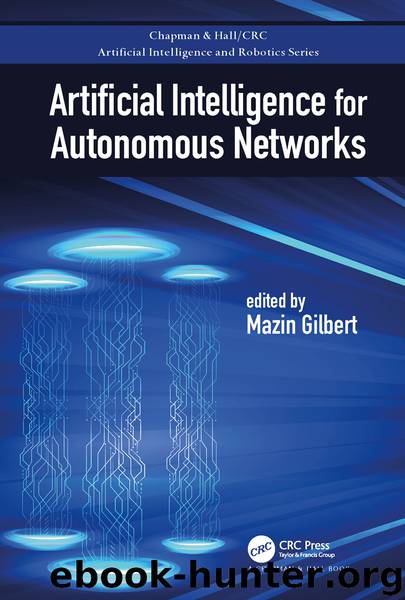Artificial Intelligence for Autonomous Networks by Mazin Gilbert

Author:Mazin Gilbert
Language: eng
Format: epub
Publisher: CRC Press
9.3.1 Autonomous Network Provisioning Vision
In a zero-touch network, network provisioning is a fully automated process—determining where and when network capacity should be deployed, deploying the network functions and then executing “test and turn up” before declaring the network functions ready for carrying production traffic.
Parts of this process is automated today—human operators forecast traffic demands into the future, collecting current demands and extrapolating on growth across different services carried over a network. Operators execute various runs of capacity planning tools to determine where to deploy new capacity. Physical network functions are deployed by technicians—manually screwing in hardware into bays in a central office. Configuration of these devices may be automated or at least semi-automated—especially where there is significant scale. And finally, operators will typically execute a set of scripts to test network functions before introducing new network functions and capacity into the network via routing configuration updates.
9.3.1.1 Capacity Planning
We first start by considering network functions that can be dynamically established or configured in near real time, such as VNFs and connectivity between network functions established as “bandwidth on demand.” Virtualization radically changes the capacity planning process compared with historic physical network elements; assuming that there is sufficient cloud capacity within the data center, new network functions can be spun up in minutes or less. If networking capacity between offices can also be provisioned rapidly to interconnect VNFs, then the historical need for traffic forecasting out months or even years is eliminated for the VNFs. We thus assume here that there is sufficient spare capacity available such that when these new network functions are required, they can be instantiated by leveraging spare server or bandwidth that is lying idle or being used by services that can be pre-empted. The VNF capacity needs here can thus be identified on demand. Traffic loads are monitored and trended over time to predict near-term future traffic demands, with decisions automatically made as to when new capacity should be automatically spun up (instantiated) on predeployed data center or network capacity. Machine learning is critical to deciding when and where to spin up new VNFs, taking into account available server and interconnecting network capacity, customer requirements (e.g., latency requirements), and more.
We all know that predicting the future can be challenging, and this is true for traffic forecasting too. Thus, eliminating this lengthy forecasting process for these network functions reduces or even eliminates the forecasting errors. This thus means that we can reduce or even eliminate the potentially large amounts of stranded capacity that forecasting errors can cause in specific locations, whilst scrambling for capacity in other locations. Similarly, traffic can be routed on the optimal routes if network capacity is available in the desired locations, contrasting with where historical errors would force traffic to be routed on suboptimal paths, resulting in longer latencies for customer traffic and inefficient capacity utilization for service providers.
Virtualization also opens up the opportunity to delete network functions when not required for a period of time or to migrate functions over time—potentially even on
Download
This site does not store any files on its server. We only index and link to content provided by other sites. Please contact the content providers to delete copyright contents if any and email us, we'll remove relevant links or contents immediately.
| Computer Vision & Pattern Recognition | Expert Systems |
| Intelligence & Semantics | Machine Theory |
| Natural Language Processing | Neural Networks |
Algorithms of the Intelligent Web by Haralambos Marmanis;Dmitry Babenko(9522)
Test-Driven Development with Java by Alan Mellor(7631)
Data Augmentation with Python by Duc Haba(7519)
Principles of Data Fabric by Sonia Mezzetta(7288)
Learn Blender Simulations the Right Way by Stephen Pearson(7208)
Microservices with Spring Boot 3 and Spring Cloud by Magnus Larsson(7036)
RPA Solution Architect's Handbook by Sachin Sahgal(6440)
Jquery UI in Action : Master the concepts Of Jquery UI: A Step By Step Approach by ANMOL GOYAL(6296)
The Infinite Retina by Robert Scoble Irena Cronin(6142)
Hadoop in Practice by Alex Holmes(6118)
Big Data Analysis with Python by Ivan Marin(5875)
Life 3.0: Being Human in the Age of Artificial Intelligence by Tegmark Max(5472)
Pretrain Vision and Large Language Models in Python by Emily Webber(4824)
Infrastructure as Code for Beginners by Russ McKendrick(4609)
WordPress Plugin Development Cookbook by Yannick Lefebvre(4326)
The Age of Surveillance Capitalism by Shoshana Zuboff(4205)
Functional Programming in JavaScript by Mantyla Dan(4202)
Embracing Microservices Design by Ovais Mehboob Ahmed Khan Nabil Siddiqui and Timothy Oleson(4102)
Applied Machine Learning for Healthcare and Life Sciences Using AWS by Ujjwal Ratan(4076)
